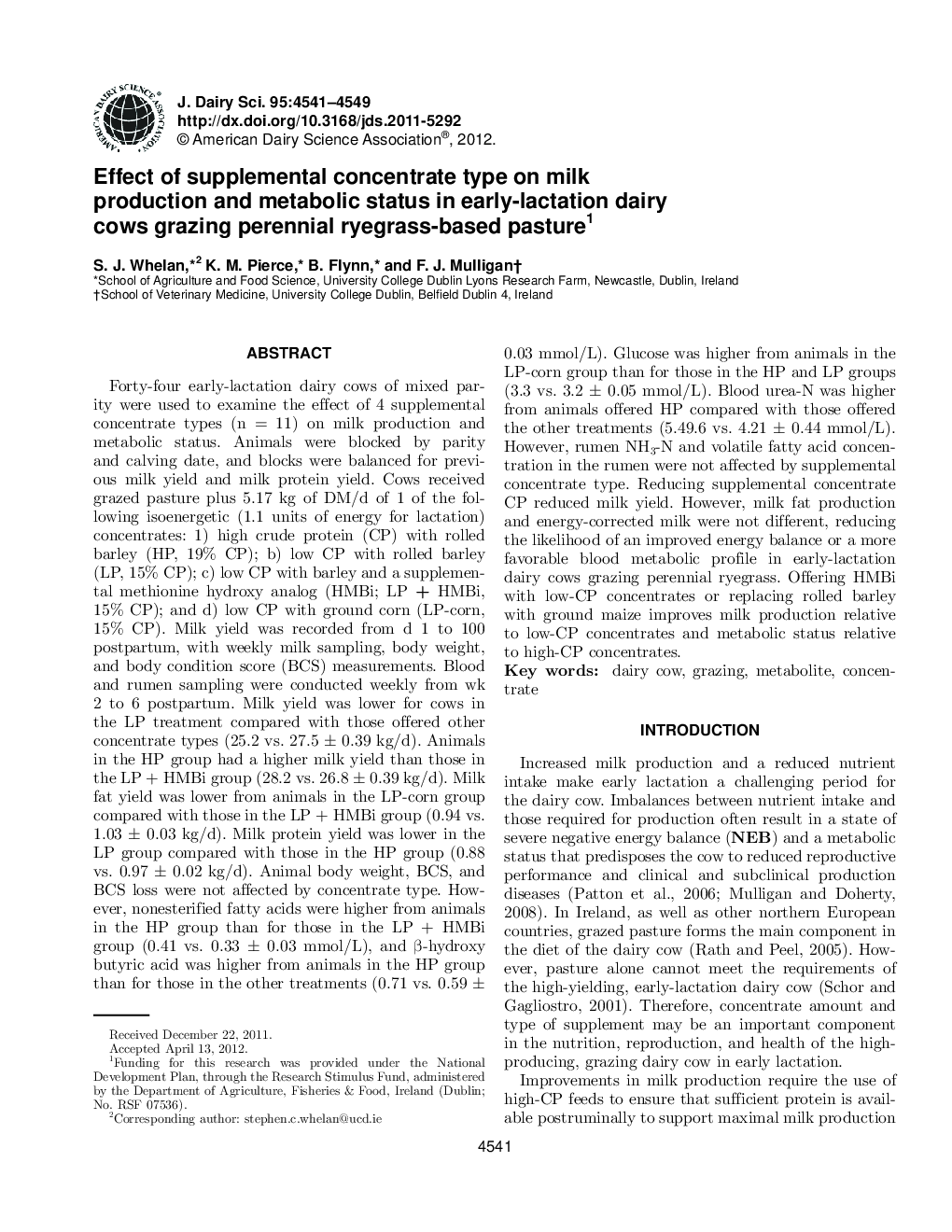| کد مقاله | کد نشریه | سال انتشار | مقاله انگلیسی | نسخه تمام متن |
|---|---|---|---|---|
| 10978880 | 1108060 | 2012 | 9 صفحه PDF | دانلود رایگان |
عنوان انگلیسی مقاله ISI
Effect of supplemental concentrate type on milk production and metabolic status in early-lactation dairy cows grazing perennial ryegrass-based pasture1
دانلود مقاله + سفارش ترجمه
دانلود مقاله ISI انگلیسی
رایگان برای ایرانیان
موضوعات مرتبط
علوم زیستی و بیوفناوری
علوم کشاورزی و بیولوژیک
علوم دامی و جانورشناسی
پیش نمایش صفحه اول مقاله

چکیده انگلیسی
Forty-four early-lactation dairy cows of mixed parity were used to examine the effect of 4 supplemental concentrate types (n = 11) on milk production and metabolic status. Animals were blocked by parity and calving date, and blocks were balanced for previous milk yield and milk protein yield. Cows received grazed pasture plus 5.17 kg of DM/d of 1 of the following isoenergetic (1.1 units of energy for lactation) concentrates: 1) high crude protein (CP) with rolled barley (HP, 19% CP); b) low CP with rolled barley (LP, 15% CP); c) low CP with barley and a supplemental methionine hydroxy analog (HMBi; LP + HMBi, 15% CP); and d) low CP with ground corn (LP-corn, 15% CP). Milk yield was recorded from d 1 to 100 postpartum, with weekly milk sampling, body weight, and body condition score (BCS) measurements. Blood and rumen sampling were conducted weekly from wk 2 to 6 postpartum. Milk yield was lower for cows in the LP treatment compared with those offered other concentrate types (25.2 vs. 27.5 ± 0.39 kg/d). Animals in the HP group had a higher milk yield than those in the LP + HMBi group (28.2 vs. 26.8 ± 0.39 kg/d). Milk fat yield was lower from animals in the LP-corn group compared with those in the LP + HMBi group (0.94 vs. 1.03 ± 0.03 kg/d). Milk protein yield was lower in the LP group compared with those in the HP group (0.88 vs. 0.97 ± 0.02 kg/d). Animal body weight, BCS, and BCS loss were not affected by concentrate type. However, nonesterified fatty acids were higher from animals in the HP group than for those in the LP + HMBi group (0.41 vs. 0.33 ± 0.03 mmol/L), and β-hydroxy butyric acid was higher from animals in the HP group than for those in the other treatments (0.71 vs. 0.59 ± 0.03 mmol/L). Glucose was higher from animals in the LP-corn group than for those in the HP and LP groups (3.3 vs. 3.2 ± 0.05 mmol/L). Blood urea-N was higher from animals offered HP compared with those offered the other treatments (5.49.6 vs. 4.21 ± 0.44 mmol/L). However, rumen NH3-N and volatile fatty acid concentration in the rumen were not affected by supplemental concentrate type. Reducing supplemental concentrate CP reduced milk yield. However, milk fat production and energy-corrected milk were not different, reducing the likelihood of an improved energy balance or a more favorable blood metabolic profile in early-lactation dairy cows grazing perennial ryegrass. Offering HMBi with low-CP concentrates or replacing rolled barley with ground maize improves milk production relative to low-CP concentrates and metabolic status relative to high-CP concentrates.
ناشر
Database: Elsevier - ScienceDirect (ساینس دایرکت)
Journal: Journal of Dairy Science - Volume 95, Issue 8, August 2012, Pages 4541-4549
Journal: Journal of Dairy Science - Volume 95, Issue 8, August 2012, Pages 4541-4549
نویسندگان
S.J. Whelan, K.M. Pierce, B. Flynn, F.J. Mulligan,